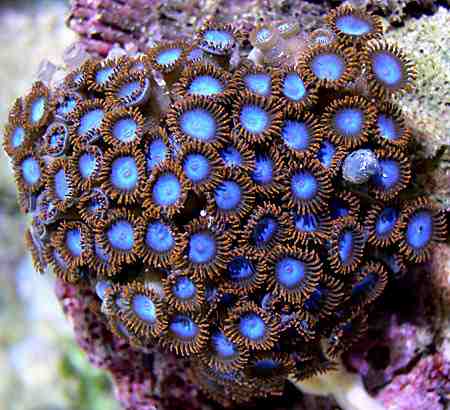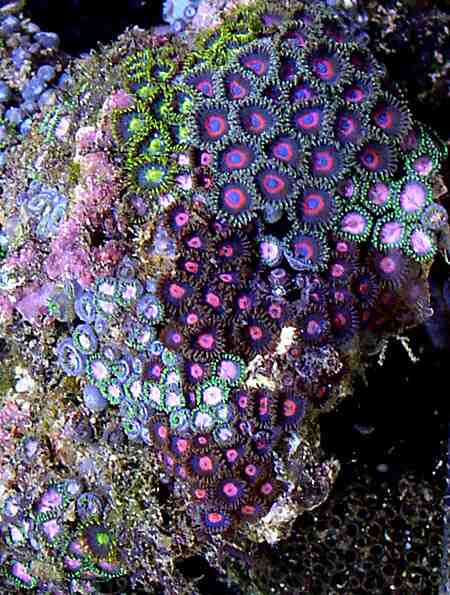Hey everyone!!! So with all this spare time i get to spend inside this summer i decided i`d like to try and post weekly coral pics and descriptions. Please anyone feel free to add any questions or comments!
So with the first one i decided to stick with something easy and very common. ZOO`S....... Everybody loves zoanthids right?
Zoanthus sp.
Kingdom: Animalia (animals)
Phylum: Cnidaria (cnidarians)
Class: Anthozoa (anemones and corals)
Subclass: Zoantharia
Order: Zoanthidea (zoanthids)
Family: Zoanthidae
Genus: Zoanthus
Species: Zoanthus alderi
Species: Zoanthus coppingeri
Species: Zoanthus danae
Species: Zoanthus mantoni
Species: Zoanthus pacificus
Species: Zoanthus pulchellus
Species: Zoanthus sociatus (green sea mat)
Species: Zoanthus solanderi
Species: Zoanthus vietnamensis
And many others, mostly unclassified


I know I know There more like an anemone than a coral and this should be in the inverts section but i`m going to be posting mostly corals so i think i`ll just keep it here.
Zoanthus sp.
Common Names: Sea Mat, Button Polyp, Sand Polyp, Polyp Rock, Colonial Anemones
Identification: Mat-like colonies of polyps with a fringe of blunt tentacles surrounding the oral disc, in contrasting shades of green, red, orange, pink, and blue. Zoo`s obtain most of there nutrition from there zooxanthellae. Some do, but most do not eat meaty foods (All eat dissolved organic matter). Some eat sea urchin eggs, chopped worms, or finely chopped fish. Zoanthus are very common and fast reproducing colonies throughout various reef zones. Their polyps are rarely larger than 0.5 in. across the oral disc. Zoanthus species normally by buds that are attached at their base to the parent colony.
Captive Care: Zoanthus colonies are highly dependent on their zooxanthellae-- rather than active feeding on zooplankton-- for energy, and should always be placed in the aquarium where they will receive bright lighting and ample water flow to help remove debris from inbetween the polyps.
Species Info
Atlantic and Pacific Species:
Zoanthus pacificus: Small to large clumped colonies of short-tentacled polyps that vary in color, usually found in shallow areas with high water movement. The oral disc is often a contrasting lighter color.
Zoanthus sociatus: Forms elaborate piecemeal mats of normally green to turquoise polyps. They are often found on reef flats exposed to high light intensity and intermittently strong currents. Stolon-connected polyps normally have 30 short tentacles, polyps are extended continuously day and night and feed predominatly on detritus, not zooplankton.
Atlantic Species:
Zoanthus pulchellus: Forms an encrusting mat so dense that polyps crowd and press against each other when expanded. Polyps are variable in color (but often brown) and have short, blunt tentacles. When unexpanded, colonies are usually hemispherical and suggest Favia like coral heads. This species is found in variable light and current conditions, with deep-water colonies occasionally fluorescent orange.
Zoanthus solanderi: Forms large, dense, fast-growing colonies primarily on reef flats and back-reef areas. Theyare aggresive competitors and are usually able to overgrow nearby sessile life.
Pacific Species:
Zoanthus coppingeri: Small polyps are not encrusted with sediment, forms large colonies on coral rubble and on colonies of M. digitata, found in bright colors, including orange, red, yellow, and green. Light and current-loving colonies are found on rocky shores and reef flats.
Zoanthus mantoni: Dark brown and green, grayish blue, or bright green polyps form a mat that is usually buried in silt and substrate up to the oral disc, and is often found along with Protopalythoa. The oral disc shows white, distinct patterns that can be quite pretty and that contrast with the tentacles. This is a lagoon species that prefers low current and bright light but is very tolerant of varying aquarium conditions.
Zoanthus vietnamensis: Forms extensive, sheetlike mauve or blue rubbery, thinly encrusting mats, the polyps are completely buried in the coenenchyme. Numerous short tentacles usually contrast in color with the rest of the colony, light blue or blue green oral discs are common. Found in areas of rough shallow water where it may occur with Palythoa and/or Protopalythoa.
Ok thats all i can type in one day. Most of this text is from
Eric Borneman`s Aquarium corals book and also Julian Sprung`s invertebrates. Pictures are from my own collection and also Reefermadness.us Let me know what you think or if there are any grammar problems and please POST MORE PICS!!! LET`S SEE EVERYONE`S ZOO COLONIES!!!!
Edited by Kyle - June 01 2006 at 1:20am